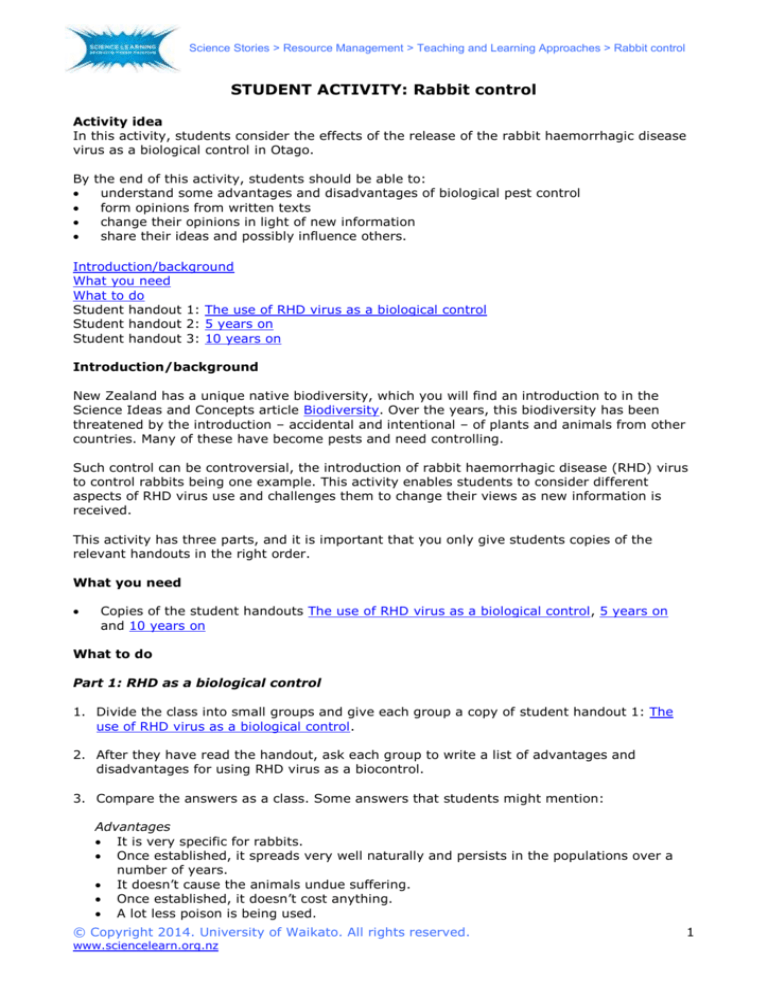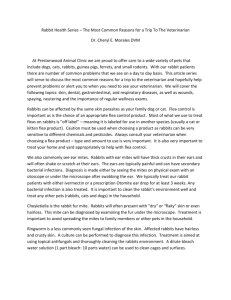
Science Stories > Resource Management > Teaching and Learning Approaches > Rabbit control
System]
STUDENT ACTIVITY: Rabbit control
Activity idea
In this activity, students consider the effects of the release of the rabbit haemorrhagic disease
virus as a biological control in Otago.
By
the end of this activity, students should be able to:
understand some advantages and disadvantages of biological pest control
form opinions from written texts
change their opinions in light of new information
share their ideas and possibly influence others.
Introduction/background
What you need
What to do
Student handout 1: The use of RHD virus as a biological control
Student handout 2: 5 years on
Student handout 3: 10 years on
Introduction/background
New Zealand has a unique native biodiversity, which you will find an introduction to in the
Science Ideas and Concepts article Biodiversity. Over the years, this biodiversity has been
threatened by the introduction – accidental and intentional – of plants and animals from other
countries. Many of these have become pests and need controlling.
Such control can be controversial, the introduction of rabbit haemorrhagic disease (RHD) virus
to control rabbits being one example. This activity enables students to consider different
aspects of RHD virus use and challenges them to change their views as new information is
received.
This activity has three parts, and it is important that you only give students copies of the
relevant handouts in the right order.
What you need
Copies of the student handouts The use of RHD virus as a biological control, 5 years on
and 10 years on
What to do
Part 1: RHD as a biological control
1. Divide the class into small groups and give each group a copy of student handout 1: The
use of RHD virus as a biological control.
2. After they have read the handout, ask each group to write a list of advantages and
disadvantages for using RHD virus as a biocontrol.
3. Compare the answers as a class. Some answers that students might mention:
Advantages
It is very specific for rabbits.
Once established, it spreads very well naturally and persists in the populations over a
number of years.
It doesn’t cause the animals undue suffering.
Once established, it doesn’t cost anything.
A lot less poison is being used.
© Copyright 2014. University of Waikato. All rights reserved.
www.sciencelearn.org.nz
1
Science Stories > Resource Management > Teaching and Learning Approaches > Rabbit control
System]
Disadvantages
It doesn’t kill all the rabbits – 10% survive.
It doesn’t affect baby rabbits of 8 weeks or younger, and if exposed, these become
immune.
Careful management is needed, as using as a biocide can give rise to an increase in the
numbers of immune rabbits.
Secondary control methods are needed to kill the immune rabbits.
4. As a class, form a continuum line of whether students think RHD should be used as a
biocontrol (strongly agree on the left, strongly disagree on the right). Encourage students
to give reasons why they choose particular points.
Part 2: 5 years on
5. Now give each group a copy of student handout 2: 5 years on.
6. After they have read the handout and discussed it in their groups, form a new continuum
line of whether students think RHD should have been used as a biocontrol. Discuss if what
happened changed their opinion and in what ways.
7. In groups, discuss and record what students predict will have happened to the rabbit
population and the biocontrol system after 10 years has elapsed.
Part 3: 10 years on
8. Now give each group a copy of student handout 3: 10 years on.
9. After reading the handout, have students discuss, if they were to go back in time, what
their advice would be to the farmers who released the virus. Advice might include:
The best time to release the virus would be when the rabbits aren’t breeding – there
would be fewer rabbits under 8 weeks old, which can become immune.
It is best not to use baits as this weakens the virus and makes it easier to develop
immunity.
The virus release needs to be followed up with another method of control such as
shooting or poisoning to kill any immune rabbits.
The virus needs to be a pure sample and not contain any less-effective virus that would
make the rabbits immune to the lethal strain.
© Copyright 2014. University of Waikato. All rights reserved.
www.sciencelearn.org.nz
2
Science Stories > Resource Management > Teaching and Learning Approaches > Rabbit control
System]
Student handout 1: The use of RHD virus as a biological control
History
Rabbits were introduced to New Zealand in the 19th century and have reproduced rapidly since
then. The population growth of this species has been supported by a favourable climate and
large areas of suitable habitats.
Rabbits have had a serious impact both economically and ecologically in New Zealand. The
economic impact was the major driving force behind the illegal introduction of rabbit
haemorrhagic disease (RHD, previously called rabbit calicivirus) into New Zealand in 1997.
Costs
Before the release of RHD, the financial cost of rabbits to New Zealand was estimated at:
$50 million a year to farm, plant nursery, horticulture, market garden and forestry
production
$25 million a year for the direct costs of destroying rabbits..
How does the virus kill the rabbits?
Rabbits are infected via the gut, from where the virus causes the rapid development of blood
clots in major organs such as the lungs, heart and kidneys. These clots block blood vessels and
quickly result in death from heart and respiratory failure in about 30–40 hours after infection.
The rabbits show no distress or bleeding before death. The virus kills around 9 out of 10
infected animals. The virus does not infect hares, but it will infect pet rabbits if exposed.
There are two ways that RHD can be used:
As a biocide, where the aim is to infect as many animals as possible by spreading large
amounts of the virus in an area. This should result in large numbers of rabbit deaths in a
short time. A risk is that the virus may not be maintained in the environment, so the
remaining immune rabbits can breed to repopulate the area. A large amount of virus would
have to be spread again to control rabbit numbers. This pattern would have to continue and
is likely to be no more efficient at controlling rabbits than a poison. Eventually, the entire
rabbit population will become immune and the virus will no longer work.
As a biocontrol, where a small amount of virus is used to infect a few rabbits. These
rabbits then infect other rabbits naturally and spread the virus more slowly. Because the
percentage of rabbits infected at any one time is much lower, there is always a pool of virus
maintained within the rabbit population. With this method of release of the virus, it should
not be necessary to reintroduce the virus at later times.
How was RHD released in New Zealand?
The first cases of RHD were found in Otago in the spring of 1997, having presumably been
smuggled into the country on dead rabbit carcasses from Australia. The disease was spread by
spraying homogenised rabbit organs onto grass and subsequently by moving carcasses of dead
animals from place to place. Therefore, the disease was being used as a biocide.
Immunity
The major line of defence that rabbits have against RHD is their immune system. Immunity to
RHD protects the rabbit from the virus so that immune rabbits will not die from this disease.
There are several circumstances that result in immunity rather than disease:
Young rabbits (less than 8 weeks old) are infected by the virus but do not die, and they
develop immunity that will protect them for life.
Not all adult rabbits die following an infection, and those that don’t (approximately 1 in 10)
are then immune to the virus.
Maternal antibodies temporarily protect rabbits born to immune mothers. If exposed to the
RHD virus at this time, these baby rabbits are likely to survive and develop antibodies,
which give them lifelong immunity to the disease.
There may be a non-lethal strain of RHD that was introduced into New Zealand at the same
time as the rabbits or the virus. This strain of RHD infects rabbits but does not kill them
and results in immunity in the rabbit that protects against the introduced strain of RHD.
© Copyright 2014. University of Waikato. All rights reserved.
www.sciencelearn.org.nz
3
Science Stories > Resource Management > Teaching and Learning Approaches > Rabbit control
System]
Students handout 2: 5 years on
Since RHD was released in the spring of 1997, the Otago Regional Council has monitored its
impact on Otago’s rabbit population.
5 years after the initial release of RHD in New Zealand, these studies show that:
rabbit populations have been held at low and stable levels following the initial RHD
epidemic in most areas of Otago
the RHD virus continues to kill rabbits and generally results in two peaks of activity – one in
early summer and the other in the autumn
since the initial epidemic, up-to-date data shows that, where RHD was originally allowed to
spread naturally (as a biocontrol) and where landowners have undertaken effective
secondary control, low rabbit levels have continued through to 2002
where higher numbers of rabbits are occurring, typically secondary control, such as
shooting or poisoning, has not been effectively undertaken
if the virus is applied to baits and left exposed to sunlight, inadvertent vaccination of rabbit
populations may occur following ingestion of dead virus, with the potential for greater
numbers of resistant adults
high numbers of adults survived exposure to the virus when it was applied as a biocide,
suggesting that these rabbits became resistant by eating dead or weakened virus, showing
the use of biocide is an unwise practice.
© Copyright 2014. University of Waikato. All rights reserved.
www.sciencelearn.org.nz
4
Science Stories > Resource Management > Teaching and Learning Approaches > Rabbit control
System]
Student handout 3: 10 years on
1080 needed for Mackenzie rabbits
Station to carry out poisoning programme
By ROB KERR – The Timaru Herald | Saturday 3 May 2008
Aerial 1080 poisoning is returning to the Mackenzie Basin after a 10-year absence as farmers
confront growing rabbit problems.
Populations of RHD (calicivirus) resistant rabbits are emerging in the high country.
The presence of RHD has removed the need for aerial control for a decade, but this month
Sawdon Station will carry out an aerial programme and other stations will follow…
Ecan [Environment Canterbury] southern biosecurity team leader Brent Glentworth said RHD
was still effective in some areas and immunity ranged from 35 to 80 percent across
populations.
Where the effectiveness of RHD was diminished, populations had reached problem levels, even
on par with rabbit numbers before the release of the virus in 1997…
Sue Allan from Sawdon Station said aerial control was a financial burden, but rabbit numbers
were affecting stock capacity. The drought had not only increased competition for feed, it had
increased rabbit numbers – dry burrows meant increased reproduction.
Haldon Station manager Paddy Boyd said aerial control cost between $40 and $70 a hectare a major cost when applied to the scale of high country farming…
Both Mr Boyd and Mrs Allen said 10 years of research would have extended RHD usefulness…
Mr Boyd didn’t like returning to 1080, which, in dry conditions, meant land could not be
stocked for up to three months. “It’s that dry, we need every bit of land we have got.”…
[Grampians Station farmer Guy King said.] “Rabbits are not just a farmer problem. On erosion
grounds, it will just become a desert basin.”
Source: www.stuff.co.nz/timaru-herald/news/399532/1080-needed-for-Mackenzie-rabbits
Additional information
The government decided against releasing RHD in 1997 because:
it might infect other animals – kiwi had been shown to develop antibodies to RHD
it might mutate and increase its host range
it might mutate and become less effective at killing rabbits while still making them immune
to a more lethal strain
the predators of rabbits might move onto preying on native species
it was likely that rabbits would eventually become immune and the virus would then be
ineffective at controlling numbers
it wasn’t known whether RHD could infect humans
if the virus was released at the wrong time, it would be less effective – when the rabbits
are breeding and the babies are under 8 weeks, they develop lifelong immunity
if the virus was released in the wrong way – as a biocide rather than a biocontrol – it would
be less effective, but farmers went to Australia to get carcasses and released it anyway.
© Copyright 2014. University of Waikato. All rights reserved.
www.sciencelearn.org.nz
5






